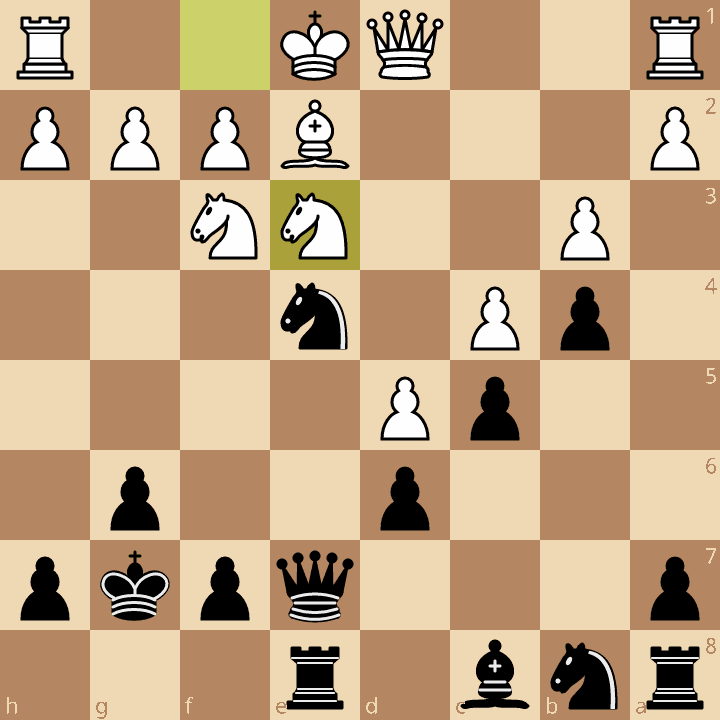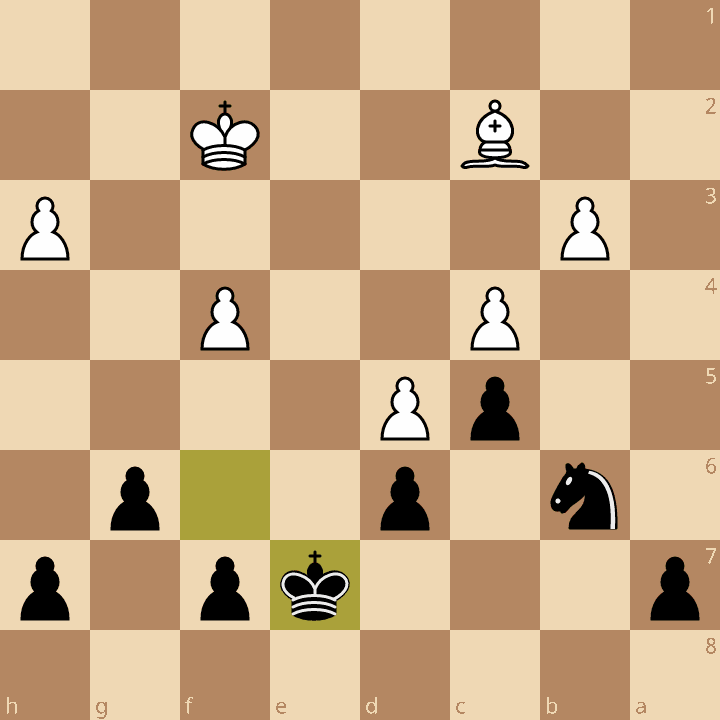Rapid Game Recap: Black in the Benko Gambit Declined
A bit of a deep-dive in a game played against a friend
I have taken to running some chess tournaments for a Facebook group I admin, and one thing we’re doing is a seasonal swiss tournament, one 15+10 game a week, for seven weeks in a row. This is round 6 of the tournament, and I got paired against a strong 1600+ chess.com rapid rated player. Our game went from the opening phase almost immediately to an Good Knight vs Bad Bishop endgame (some call this the “Fischer Endgame”).
Time Control: 15+10 second increment
White: Aaron (1634 chess.com Rapid)
Black: Me (1699 chess.com Rapid)
The Opening
Our game started out 1.d4 Nf6 2.Nf3 c5
My opponent admitted to have not seen this move before. White’s overwhelming choice here is to push 3.d5, which my opponent also chose. After d5, I played 3…b5, which looks like a Benko Gambit, but given that there is no pawn on c4, at the moment it only superficially looks like a Benko Gambit, which is why this is called the “Pseudo-Benko".
My opponent responded with 4.e3, which looks a bit timid but does just threaten to win the pawn on b4. By this time I’m out of book, but I figured that 4…b4 would keep me in Benko Gambit Declined territory if my opponent ever played so I responded with that. Other options I considered briefly were a6, simply protecting the pawn, and Bb7, attacking the d5 pawn. I rejected a6 as a bit passive, and Bb7 I thought would just run into the move 5.c4
Sure enough, my opponent responded with 5.c4, bringing us from a Pseudo-Benko to an actual Benko Gambit Declined position I was more familiar with.
5…d6 6.Bd3 g6 7.b3 Bg7 8.Bb2 O-O 9.Nbd2
The above moves up to 8…O-O felt like standard developing moves with a lot of tension on the dark squares and that long a1-h8 diagonal. But 9.Nbd2 seemed a bit of an inaccuracy since White was not yet castled. I felt like here I had an opportunity to play for the initiative by opening the position right away with 9…e6. My opponent responded with 10.e4, which I felt was a concession in itself since it showed that 4…e3 was a wasted tempo. But it also allowed me to open the center on my terms with 10…exd5. My opponent replied instantly with 11.exd5, but more interesting would have been 11.cxd5, simply because of the non-symmetrical pawn structure and imbalanced position in the center and queenside.
11.exd5 gave me an immediate plus: 11…Re8+ 12.Be2
12…Qe7 was my choice here, piling on the bishop on e2 to prevent White castling.
An interesting idea here which I considered but decided against was the typical Nxd5! sacrifice. It’s typical in these Benko Gambit Declined structures with b3 because of the weak diagonal and the rook on a1, but I did not look very hard at this. Had I spent more time, I would have seen 12…Nxd5 13.Bxg7 Nf4!, where black has won a pawn and is about to wreak havoc on the centralized king position. For instance 14.Bh6 Nxe2. Black threatens discoveries to win the white queen, white cannot castle, and despite the dark square weaknesses on Black’s kingside, white can barely exploit these. If a move like 15.Be3 Nc3 is an eternal outpost for black’s knight, Qf6, Bf5, and white’s position is huge mess.
My opponent realized he couldn’t castle, and needed to block the e-file, so he played 13.Nf1, intending Ne3. I saw this idea, and responded with 13…Ne4 14.Bxg6 Kxg7. Then came 15.Ne3.
Here comes a typical tactic: 15…Nxf2! 16. Kxf2 Qxe3+ 17.Kf1
I took a minute to assess the situation: My opponent’s bishop on e2 is rather poor, because of all the queenside pawns on the same color, so its movement and usefulness is very restricted. My opponent has also lost castling rights and the rook on h1 is out of play. My queenside is not very developed, but I have time for moves like Bg4, Nd7-e5/f6, Re7+Rae8, doubling on the open e-file. I’m up a pawn, but my advantage here is clearly more than that.
17…Bg4 18.Qd3, offering a queen trade, but going into a bad endgame a pawn down.
The Endgame
I accepted: 18…Qxd3 19.Bxd3 and decided to get rid of White’s last useful minor piece with 19…Bxf3 20.gxf3
I’m very pleased with the position because of how bad White’s bishop is and how unassailable the dark squares are. Strategically and materially this position is entirely won for Black.
20…Nd7 21.Kf2 Ne5 (moving on with my plan from before) 22.Bc3 Re7 23.Rhe1 Rae8 24.h3
So far, very smooth. White’s bishop is in an even worse state and I have full control of the e-file. Perhaps for this reason, my next move was a bit of a mistake.
24…Nd7? I felt that this was a good choice since it simplifies the position, but the computer marks it as a mistake, and it was not easy for me to see why. The suggested top move by Stockfish is 24…g5, simply preventing the kingside pawns from moving to a dark square. I looked at the continuations and they were far from obvious, but I see the merit of keeping the rooks on the e-file when they’re starting at the enemy rook on e1 — the position is a bit paralyzing for White and it’s hard to suggest a move that is any good.
25.Rxe7 Rxe7 26.a3
This move give me a bit of worry, because it was a strong bid for counterplay. This also exposes one reason why allowing the rook trade wasn’t as good. Supposing white played a3 after g5, I can freely capture, as if White takes back, the Rook on e1 is now hanging after a move like Nd3+ and I win the exchange.
After some deliberation, I decided I could hold the queenside and still make progress on the kingside, so I took.
26…bxa3 27.Rxa3 Nb6 28.Ra1
Here I thought my opponent would go for Ra6 in order to put pressure on my backwards d6-pawn, but instead he decided to retreat, so I tried to set up a tactic with 28…Rb7, with the idea of Nxc5 in some variation. 29.Re1, perhaps looking for the e8 square? 29…Kf6 30.f4 and I offered a rook trade with 30…Re7?! My opponent accepted with 31.Rxe7, but this was too obliging (31.Ra1, continuing to tie me down to the queenside would have been a good idea). 31…Kxe7 and this is a straightforward win.
My first plan: Create a passed pawn on the kingside and put it on a dark square, safe from the light-square bishop:
32.Kf3 Kf6 33.h4 Nd7 34.h5 h6 (preventing 35.h6) 35.hxg6 fxg6 (passed pawn created) 36.Kg4 (threatening f5) g5! 37.fxg5+ hxg5
Now I have an unassailable passed pawn that ties down the enemy king.
Next plan: Dislodge the bishop and cover enough squares to advance the pawn.
38.Kh5 a5 (I take time out to prevent any attempt to break through on the queenside, which was not really a threat, but this also passes the move back to White to try to make any progress). 39.Kg4 Ne5+ 40.Kh5 Nf3 41.Kg4 Bd4 (punching at the bishop) 42.Bd1 Nf5 (threat: Ne3+) 43.Bc2 (missing the threat — White could have put up more resistance with Be2, but the knight moves to d4, taking away too many squares from the bishop, and allowing black Kg6, after which White is in zugzwang and must give way and allow Kf5 and black continues to progress).
43…Ne3+. This is resignable, but my opponent played on sportingly anyway, and I easily won via pawn promotion to queens and checkmated him on the corner of the board on the 61st move.
Here’s a full gif of the game:
Lessons learned:
Do not simplify too early! I could have held on to an advantage and forced more concessions if I hadn’t gone for the rook trades so soon.
Look deeper at ideas rather than rejecting them outright. Simply looking at the early Nxd5 tactic would have made me realize I’m winning a pawn and the game immediately, rather than sacrificing a piece for unclear compensation. Had I spent more time here I would have had an easier win.
P.S. Give me feedback in the comments: Do you want to see these kind of personal game recap posts? Too boring? Too confusing? Got questions I can answer? Personally I enjoy writing them for my own sake, but it’s always nice to know what other folks think! Thanks for reading!



















Nice post! Nxd5 would’ve been 🔥